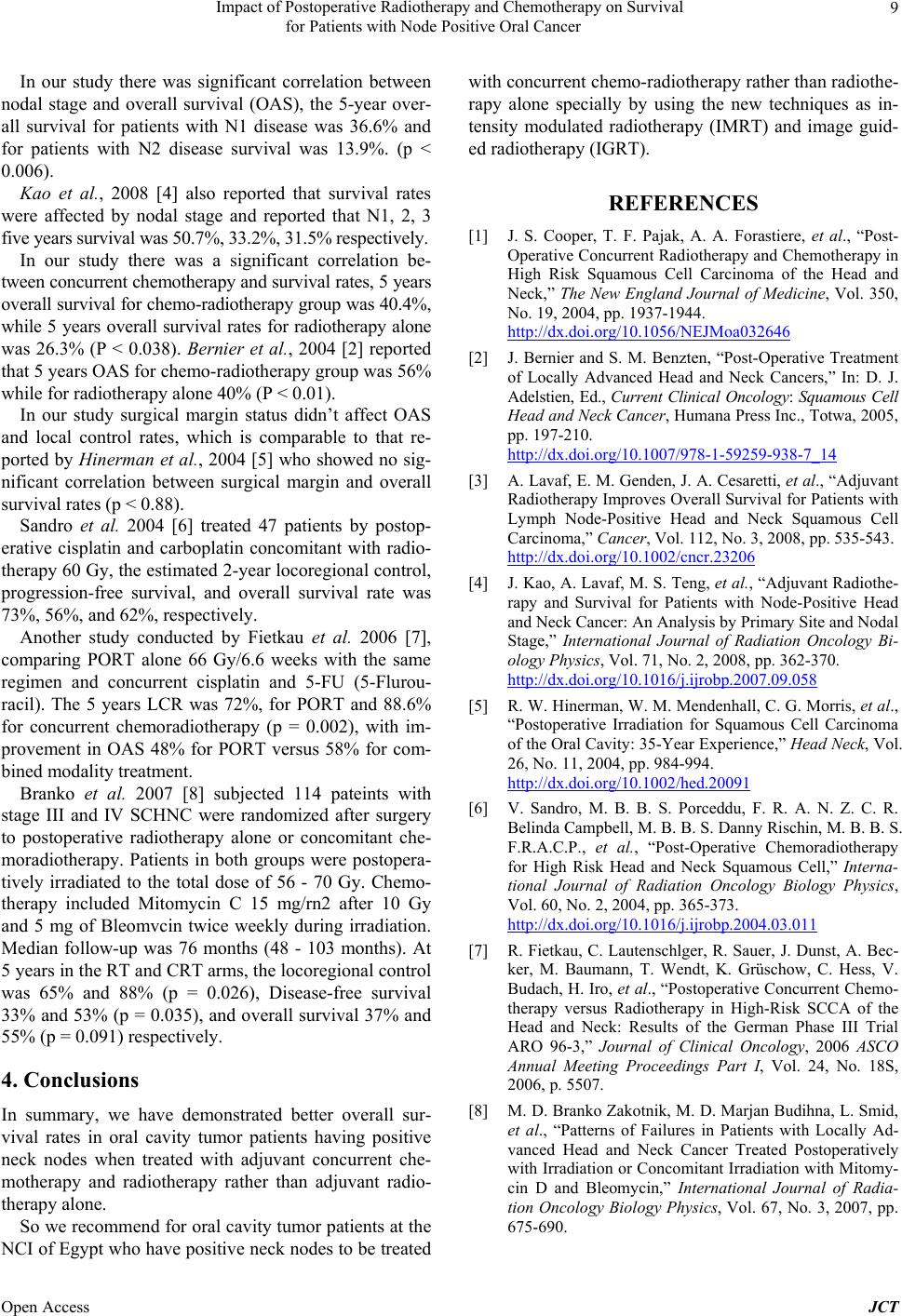
Impact of Postoperative Radiotherapy and Chemotherapy on Survival
for Patients with Node Positive Oral Cancer
9
In our study there was significant correlation between
nodal stage and overall survival (OAS), the 5-year over-
all survival for patients with N1 disease was 36.6% and
for patients with N2 disease survival was 13.9%. (p <
0.006).
Kao et al., 2008 [4] also reported that survival rates
were affected by nodal stage and reported that N1, 2, 3
five years survival was 50.7%, 33.2%, 31.5% respectively.
In our study there was a significant correlation be-
tween concurrent chemotherapy and survival rates, 5 years
overall survival for chemo-radiotherapy group was 40.4%,
while 5 years overall survival rates for radiotherapy alone
was 26.3% (P < 0.038). Bernier et al., 2004 [2] reported
that 5 years OAS for chemo-radiotherapy group was 56%
while for radiotherapy alone 40% (P < 0.01).
In our study surgical margin status didn’t affect OAS
and local control rates, which is comparable to that re-
ported by Hinerman et al., 2004 [5] who showed no sig-
nificant correlation between surgical margin and overall
survival rates (p < 0.88).
Sandro et al. 2004 [6] treated 47 patients by postop-
erative cisplatin and carboplatin concomitant with radio-
therapy 60 Gy, the estimated 2-year locoregional control,
progression-free survival, and overall survival rate was
73%, 56%, and 62%, respectively.
Another study conducted by Fietkau et al. 2006 [7],
comparing PORT alone 66 Gy/6.6 weeks with the same
regimen and concurrent cisplatin and 5-FU (5-Flurou-
racil). The 5 years LCR was 72%, for PORT and 88.6%
for concurrent chemoradiotherapy (p = 0.002), with im-
provement in OAS 48% for PORT versus 58% for com-
bined modality treatment.
Branko et al. 2007 [8] subjected 114 pateints with
stage III and IV SCHNC were randomized after surgery
to postoperative radiotherapy alone or concomitant che-
moradiotherapy. Patients in both groups were postopera-
tively irradiated to the total dose of 56 - 70 Gy. Chemo-
therapy included Mitomycin C 15 mg/rn2 after 10 Gy
and 5 mg of Bleomvcin twice weekly during irradiation.
Median follow-up was 76 months (48 - 103 months). At
5 years in the RT and CRT arms, the locoregional control
was 65% and 88% (p = 0.026), Disease-free survival
33% and 53% (p = 0.035), and overall survival 37% and
55% (p = 0.091) respectively.
4. Conclusions
In summary, we have demonstrated better overall sur-
vival rates in oral cavity tumor patients having positive
neck nodes when treated with adjuvant concurrent che-
motherapy and radiotherapy rather than adjuvant radio-
therapy alone.
So we recommend for oral cavity tumor patients at the
CI of Egypt who have positive neck nodes to be treated
with concurrent chemo-radiotherapy rather than radiothe-
rapy alone specially by using the new techniques as in-
tensity modulated radiotherapy (IMRT) and image guid-
ed radiotherapy (IGRT).
N
REFERENCES
[1] J. S. Cooper, T. F. Pajak, A. A. Forastiere, et al., “Post-
Operative Concurrent Radiotherapy and Chemotherapy in
High Risk Squamous Cell Carcinoma of the Head and
Neck,” The New England Journal of Medicine, Vol. 350,
No. 19, 2004, pp. 1937-1944.
http://dx.doi.org/10.1056/NEJMoa032646
[2] J. Bernier and S. M. Benzten, “Post-Operative Treatment
of Locally Advanced Head and Neck Cancers,” In: D. J.
Adelstien, Ed., Current Clinical Oncology: Squamous Cell
Head and Neck Cancer, Humana Press Inc., Totwa, 2005,
pp. 197-210.
http://dx.doi.org/10.1007/978-1-59259-938-7_14
[3] A. Lavaf, E. M. Genden, J. A. Cesaretti, et al., “Adjuvant
Radiotherapy Improves Overall Survival for Patients with
Lymph Node-Positive Head and Neck Squamous Cell
Carcinoma,” Cancer, Vol. 112, No. 3, 2008, pp. 535-543.
http://dx.doi.org/10.1002/cncr.23206
[4] J. Kao, A. Lavaf, M. S. Teng, et al., “Adjuvant Radiothe-
rapy and Survival for Patients with Node-Positive Head
and Neck Cancer: An Analysis by Primary Site and Nodal
Stage,” International Journal of Radiation Oncology Bi-
ology Physics, Vol. 71, No. 2, 2008, pp. 362-370.
http://dx.doi.org/10.1016/j.ijrobp.2007.09.058
[5] R. W. Hinerman, W. M. Mendenhall, C. G. Morris, et al.,
“Postoperative Irradiation for Squamous Cell Carcinoma
of the Oral Cavity: 35-Year Experience,” Head Neck, Vol.
26, No. 11, 2004, pp. 984-994.
http://dx.doi.org/10.1002/hed.20091
[6] V. Sandro, M. B. B. S. Porceddu, F. R. A. N. Z. C. R.
Belinda Campbell, M. B. B. S. Danny Rischin, M. B. B. S.
F.R.A.C.P., et al., “Post-Operative Chemoradiotherapy
for High Risk Head and Neck Squamous Cell,” Interna-
tional Journal of Radiation Oncology Biology Physics,
Vol. 60, No. 2, 2004, pp. 365-373.
http://dx.doi.org/10.1016/j.ijrobp.2004.03.011
[7] R. Fietkau, C. Lautenschlger, R. Sauer, J. Dunst, A. Bec-
ker, M. Baumann, T. Wendt, K. Grüschow, C. Hess, V.
Budach, H. Iro, et al., “Postoperative Concurrent Chemo-
therapy versus Radiotherapy in High-Risk SCCA of the
Head and Neck: Results of the German Phase III Trial
ARO 96-3,” Journal of Clinical Oncology, 2006 ASCO
Annual Meeting Proceedings Part I, Vol. 24, No. 18S,
2006, p. 5507.
[8] M. D. Branko Zakotnik, M. D. Marjan Budihna, L. Smid,
et al., “Patterns of Failures in Patients with Locally Ad-
vanced Head and Neck Cancer Treated Postoperatively
with Irradiation or Concomitant Irradiation with Mitomy-
cin D and Bleomycin,” International Journal of Radia-
tion Oncology Biology Physics, Vol. 67, No. 3, 2007, pp.
675-690.
Open Access JCT